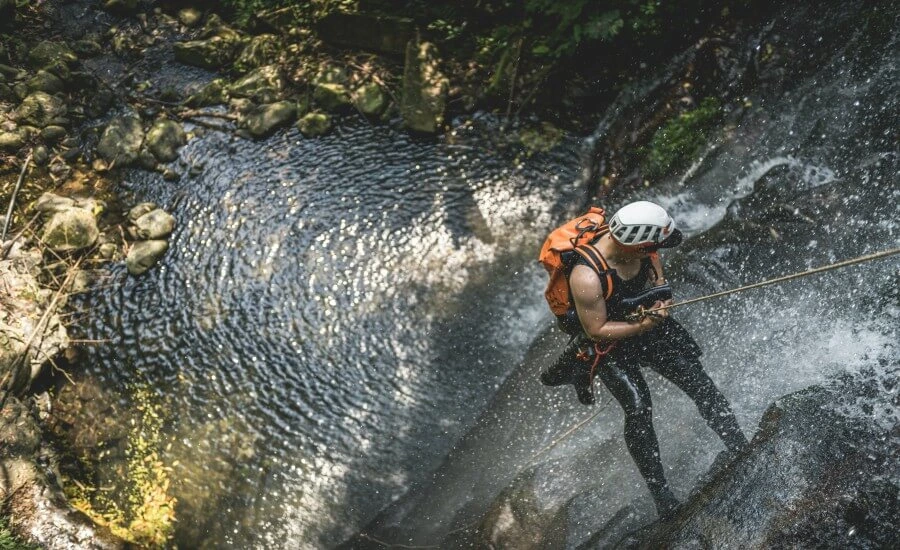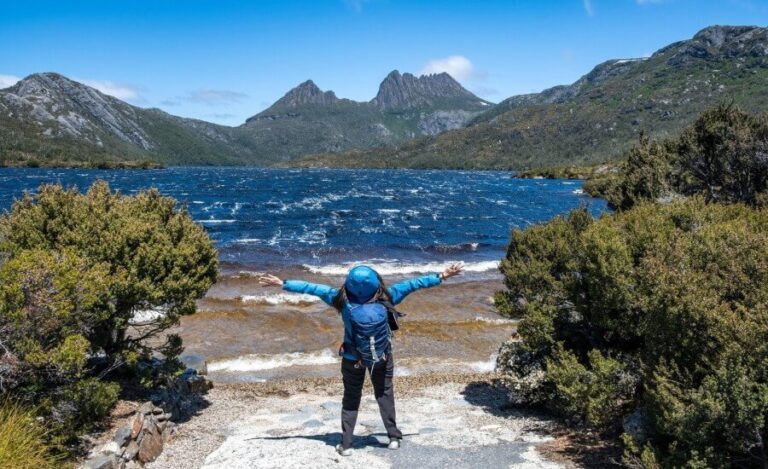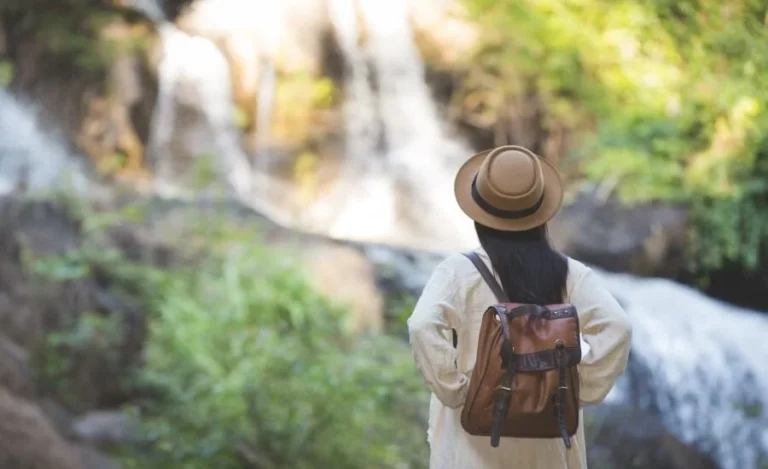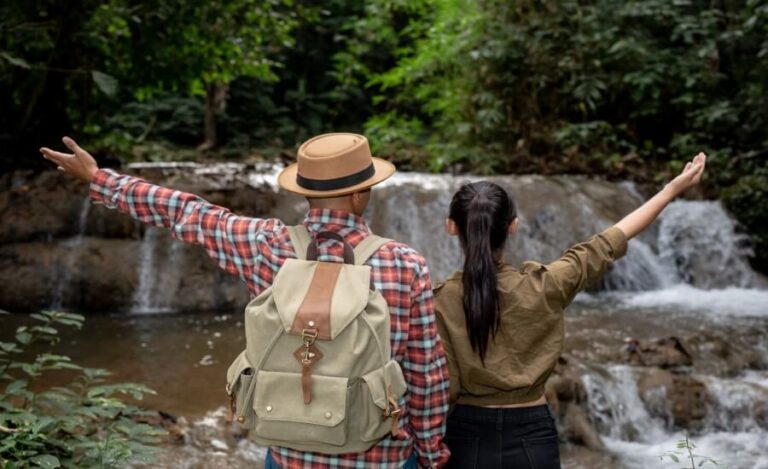
Imagine standing at the lip of a narrow slot canyon, the rock walls plunging into cool shadows below. A hidden world awaits, sculpted by water and time, accessible only to those willing to descend. You take a deep breath, check your harness one last time, and lean back, trusting the rope as you begin your rappel beside a cascading waterfall. This is the heart-pounding, awe-inspiring world of canyoneering – an adventure that blends hiking, scrambling, climbing, swimming, and rappelling into one unforgettable journey.
Canyoneering (often called ‘canyoning’ outside the US) is more than just a sport; it’s an immersive exploration of some of Earth’s most beautifully hidden landscapes. It demands respect for nature, technical skill, problem-solving, teamwork, and a healthy dose of adventurous spirit.
If you’re drawn to the allure of exploring these geological wonders, this Beginner’s Guide to Canyoneering is your starting point. We’ll delve into what the adventure entails, the basic skills and gear required, crucial safety protocols, and how you can safely take your first steps into this captivating activity.
Canyoneering 101: A Beginner’s Guide to the Adventure of a Lifetime

At its core, canyoneering is the sport of exploring canyons by descending through them. Unlike hiking to a viewpoint, canyoneering involves traveling down and through the canyon itself, often following the path water has carved over millennia. This journey typically requires navigating a variety of obstacles using a combination of techniques:
- Hiking & Scrambling: Traversing flatter sections or navigating uneven terrain and boulders.
- Downclimbing: Carefully climbing down short drops or obstacles without ropes, using hands and feet.
- Stemming/Bridging/Chimneying: Using opposing pressure with hands and feet against canyon walls to move through narrow sections or over obstacles.
- Swimming or Wading: Negotiating pools or flowing water sections.
- Sliding: Utilizing natural water slides formed by smooth rock.
- Jumping: Plunging into deep pools from ledges (only after verifying depth and safety!).
- Rappelling (Abseiling): The signature technique – using ropes, harnesses, and descenders to control your descent down vertical drops, cliffs, or waterfalls.
Canyons themselves vary immensely. Some are “dry canyons,” found mostly in desert regions like the American Southwest, involving primarily rock scrambling and rappelling. Others are “wet canyons,” common in mountainous areas or during monsoon seasons (like parts of India’s Western Ghats or Meghalaya), involving significant water flow, swimming, and waterfall rappels.
The term “canyoning” is often associated more with these wetter environments globally, while “canyoneering” is common in the US, but fundamentally, they describe the same multi-faceted activity of canyon descent. It’s an adventure that demands adaptability and respect for the unique challenges each canyon presents.
Essential Skills: Beyond Just Walking

While canyoneering doesn’t always require elite athleticism, it does demand more than just hiking ability. Beginners should focus on developing foundational skills and, crucially, gain technical rope skills under expert guidance before attempting technical descents independently.
- Navigation: Canyons can be complex environments. Basic map reading, compass use, and potentially GPS skills are essential, especially for approaches and exits. Understanding route descriptions (“beta”) is key.
- Scrambling & Downclimbing: Confidently moving over uneven, rocky terrain, using hands for balance, and safely descending short drops without ropes is fundamental. Good footwork and balance are crucial.
- Swimming Ability: For wet canyons, being a comfortable swimmer is often necessary. You might need to swim across pools, potentially wearing a backpack and wetsuit. Understanding basic water dynamics (currents, hydraulics) is also important.
- Problem-Solving & Decision Making: Canyoneering involves constantly assessing obstacles and choosing the safest way forward. This requires good judgment, communication within the team, and the ability to adapt to changing conditions.
- Basic Rope Work Awareness (Learn from Experts!): While beginners won’t be setting up complex systems, understanding the concepts is vital. This includes:
- Knots: Knowing basic, secure knots like the Figure 8 Follow-Through (for tying into harness) or Overhand/Figure 8 on a Bight (for anchor loops) – these must be learned and practiced with instructors.
- Rappelling Concept: Understanding how the rope, anchor, harness, and descender work together for a controlled descent. Initial rappels should always be under direct supervision and often with a safety backup (belay).
- Anchor Awareness: Recognizing different types of anchors (natural like trees/rocks, bolted) and understanding the absolute importance of assessing their security (again, initially relying on guide/instructor expertise).
- Knots: Knowing basic, secure knots like the Figure 8 Follow-Through (for tying into harness) or Overhand/Figure 8 on a Bight (for anchor loops) – these must be learned and practiced with instructors.
Physical fitness (endurance for hiking, some upper body strength for scrambling/pulling ropes) is helpful, but sound judgment, willingness to learn, and teamwork are paramount.
Gearing Up: Essential Canyoneering Equipment for Beginners

Having the right gear is crucial for both safety and comfort in canyoneering. While guided trips often provide technical equipment, understanding the basics is important. Here’s a rundown of essential gear, noting that beginners should always have their gear checked by an experienced leader or guide:
Personal Gear:
- Helmet: Non-negotiable! Protects from rockfall and impacts. A climbing or canyoneering-specific helmet is required.
- Harness: A comfortable climbing or, ideally, a more durable canyoneering-specific harness (often with a protective seat patch). Must fit properly.
- Rappel Device (Descender): An ATC-style device can work initially, but canyoning-specific descenders (like Petzl Pirana, Kong Oka, etc.) offer better friction control, heat dissipation, and ease of use with wet/muddy ropes. Learn to use your specific device with an instructor.
- Locking Carabiners: Several are needed. Typically at least one large HMS pear-shaped carabiner for the rappel device, and smaller locking carabiners for lanyards/safety tethers. Screw-gates or auto-lockers work.
- Footwear: Sturdy, closed-toe shoes with excellent grip on wet rock and good drainage are essential. Dedicated canyoneering shoes are best, but sticky-soled approach shoes or even sturdy trail runners can work for simpler canyons. Avoid open sandals or flimsy shoes.
- Backpack: A durable pack that can withstand abrasion. Canyoneering-specific packs have drainage holes and are made of tough materials. 20-40 liters is typical.
- Dry Bag(s): To keep essentials (first aid, extra layers, phone, snacks) dry inside your backpack.
- Wetsuit (for wet/cold canyons): Essential for thermal protection in cold water. Thickness depends on conditions (3mm for cool water, 5mm+ for cold). A full wetsuit is generally better than a shortie.
- Appropriate Clothing: Quick-drying synthetic layers. Avoid cotton (it stays wet and cold). Thermal layers under a wetsuit if needed.
- Gloves (Optional but Recommended): Protect hands during rappels and scrambling.
- Whistle: For signaling in noisy environments.
- Headlamp/Torch: Essential, even for day trips, in case of delays or dark canyon sections. Bring spare batteries.
Group/Technical Gear (Initially provided/managed by guides/leaders):
- Static Ropes: Specific canyoneering ropes designed for low stretch and durability. Length must be at least twice the longest rappel (or use a pull cord system).
- Webbing & Rapide Links/Rings: For building or reinforcing anchors.
- First-Aid Kit: Comprehensive kit appropriate for wilderness settings.
- Navigation Tools: Map, compass, GPS device.
- Emergency Communication: PLB or satellite messenger for remote areas.
Always inspect your gear before each trip and replace anything worn or damaged. Never compromise on safety equipment.
Safety First, Adventure Second: Crucial Canyoneering Safety Rules

Canyoneering is inherently risky. Natural hazards, technical challenges, and remote locations demand a rigorous focus on safety. While adventure is the goal, it should never overshadow safe practices. Beginners must internalize these fundamental safety principles:
- Go with Experience: Never attempt a technical canyon alone or with only other beginners. Your first trips should always be with certified guides or highly experienced mentors who can teach you safe techniques.
- Check the Weather RELENTLESSLY: Flash floods are the single biggest objective hazard. Check detailed forecasts for the canyon area and the entire watershed above it. Understand monsoon patterns (common in India during rainy season). If there’s any significant rain predicted, postpone or choose a different activity. Be prepared to observe changing conditions in the canyon.
- Master Rappelling Basics (Under Supervision): Learn proper rappelling technique from an expert. Always use a backup/belay system when learning. Ensure hair and loose clothing are secured away from the descender. Control your speed; avoid bouncing.
- ANCHORS ARE LIFE: This is critical. Never trust an anchor without thorough inspection. Learn (from experts) how to assess natural anchors (trees, rock features) and fixed anchors (bolts, webbing). Webbing degrades rapidly in sunlight and weather – always check its condition. If in doubt, back it up or build a new, solid anchor (requires training!).
- Never Jump or Slide Blind: Always check the depth and landing zone of pools before jumping or sliding. Send someone down on rappel first to probe for hidden rocks, debris, or shallow spots. Water levels can change dramatically.
- Wear Your Helmet ALWAYS: Rockfall is a constant risk, as are slips and falls. Keep your helmet on from the moment you approach the canyon until you are safely out.
- Know Your Route & Skills: Research the canyon thoroughly (“beta”). Understand its rating (e.g., ACA Class A/B/C, technical ratings 1/2/3/4) and required skills. Be honest about your abilities and your group’s weakest link. Don’t attempt canyons beyond your current skill level.
- Water Awareness (Wet Canyons): Understand the power of moving water (hydraulics, currents). Wear appropriate thermal protection (wetsuit) to prevent hypothermia, even on warm days if the water is cold. Know basic swiftwater safety principles if applicable.
- Communication is Key: Maintain clear communication within your group, especially around rappels or obstacles. Use standard voice, whistle, or hand signals. Ensure everyone understands the plan.
- Leave No Trace: Canyons are fragile ecosystems. Pack out everything you pack in (including human waste – use WAG bags). Stay on established paths where possible. Avoid damaging vegetation or disturbing wildlife. Minimize rope grooves on rock by using rappel rings and proper technique. Use removable anchors where feasible.
Safety in canyoneering relies on knowledge, judgment, preparation, and conservative decision-making.
Your First Descent: Tips for a Successful Beginner Canyoneering Trip

Your first canyoneering trip is exciting! To make it safe and enjoyable, keep these tips in mind:
- Choose a Guided Trip or Experienced Mentor: This is the safest way to start. Let professionals handle the technical rigging and safety while you focus on learning and enjoying the experience. Reputable guiding companies operate in many popular canyoneering areas globally and sometimes locally (research needed for specific areas in India).
- Pick an Appropriate Beginner Canyon: Start with a Class A (non-technical) or Class B (basic rappels, no significant water) canyon, or a canyon rated technically easy (e.g., ‘3’ in some systems). Your guide will choose suitable routes.
- Listen Carefully & Ask Questions: Pay close attention to instructions from your guide or leader, especially regarding safety procedures and rappelling. Don’t be afraid to ask questions if you’re unsure about anything.
- Communicate Your Comfort Level: If you’re feeling nervous (especially about heights or water), let your guide know. They can offer extra support, reassurance, and potentially alternative ways to navigate an obstacle.
- Focus on Technique, Not Speed: Take your time, especially on rappels and tricky footing. Move deliberately and focus on applying the techniques you’re being taught correctly.
- Stay Hydrated & Fueled: Drink water regularly, even if you don’t feel thirsty. Bring high-energy snacks. Canyoneering can be more physically demanding than it looks.
- Manage Expectations: It might be challenging! You might get wet, cold, or tired. Embrace the adventure and focus on the unique environment and the sense of accomplishment.
- Be a Good Team Member: Look out for others in the group, offer encouragement, help with carrying gear if appropriate, and maintain a positive attitude.
- Enjoy the Scenery! Don’t forget to pause and appreciate the incredible beauty of the canyon environment. Notice the rock formations, the light, the water, the plants.
Your first trip is about learning the ropes (literally!) and discovering if this amazing sport is for you.
Finding Your Footing: How to Get Started with Canyoneering

Hooked after your first taste? Transitioning from guided trips to becoming a competent recreational canyoneer requires dedication to learning and practice. Here’s how to progress:
- Take a Comprehensive Beginner’s Course: This is the single most important step. Look for courses taught by certified instructors (e.g., through organizations like the American Canyon Guides Association – ACGA, ICOPro internationally, or reputable local guiding services). A good course (typically 3-4 days) will cover:
- Essential knots
- Rappelling techniques (various devices, friction control, locking off)
- Anchor building and evaluation (natural and bolted)
- Basic rigging (static and releasable systems)
- Rope management
- Movement techniques (downclimbing, stemming)
- Basic self-rescue (ascending ropes, assisting others)
- Hazard awareness (flash floods, hypothermia)
- Leave No Trace ethics
- Practice Skills: Dry-land practice (knots, rigging) is essential. Find safe, controlled environments (like a climbing gym with rappel stations, or appropriate outdoor cliffs with expert supervision) to practice rappelling and rope ascending.
- Go with Mentors: Seek out experienced canyoneers who are willing to mentor beginners. Join trips led by people whose judgment and skills you trust. Learn by observing and doing under their guidance.
- Join a Community: Connect with local or online canyoneering groups or clubs. This is a great way to find partners, learn about local canyons, and share knowledge. (Check platforms like Meetup or dedicated forums).
- Start Easy & Progress Gradually: Begin with technically simpler canyons and slowly increase the difficulty as your skills, experience, and judgment develop. Don’t rush into complex or remote canyons. Research routes meticulously.
- Continuously Learn: Canyoneering techniques and gear evolve. Stay updated, consider intermediate and advanced courses (e.g., swiftwater rescue, advanced rigging, self-rescue) as you progress.
Building competence takes time and deliberate practice. Prioritize safety and foundational skills over ticking off difficult canyons early on.
Common Concerns & Solutions

It’s natural for beginners to have fears about canyoneering. Here’s how to approach common anxieties:
- Fear of Heights/Exposure: This is very common, especially with rappelling.
- Solution: Start with shorter rappels in controlled environments. Focus meticulously on the technical steps (checking gear, proper technique) rather than the height. Trust your training, gear, and guide/backup system. Breathe deeply. Communicate your fear – good guides offer excellent support. Exposure therapy (gradual, safe exposure) helps build confidence over time.
- Fear of Water (Swimming, Cold, Confined Spaces): Wet canyons can be intimidating.
- Solution: Ensure you have adequate swimming skills for the chosen canyon (or pick dry/low-water routes). Wear the appropriate wetsuit – being warm drastically reduces anxiety. Understand water dynamics and follow safety protocols strictly. Start with canyons that have easy water sections or options to bypass deep pools. Again, communicate your concerns.
- Fear of Technical Skills/Making Mistakes: Worrying about knot tying, rigging, or rappelling errors.
- Solution: Thorough training and practice build competence and confidence. Always double-check your setup (and have your partner/guide check). Start simple and master basics before progressing. Go with experienced people who create a safe learning environment. Understand that mistakes can happen; focus on redundancy and having backup plans/rescue skills.
- Fear of Getting Stuck (Potholes, Narrow Sections): Claustrophobia or fear of inescapable situations.
- Solution: Research routes carefully – descriptions often mention tight sections or “keeper potholes.” Avoid these features until you have the skills and experience (or guidance) to manage them. Learn techniques for escaping potholes (partner assists, pack tosses, specialized gear – advanced skills). Communicate claustrophobic concerns when selecting routes.
Acknowledging fears, getting proper training, starting slow, and going with supportive, experienced people are the best ways to manage anxieties and build confidence.
Pre-Canyoneering Checklist: Final Preparations

Before heading out on any canyoneering trip (especially once you start going independently or with peers), run through this final checklist:
- Weather Forecast Checked (AGAIN!): Detailed check for the canyon area AND the entire upstream watershed. Check multiple sources if possible. Understand the flash flood potential.
- Route Beta Reviewed: Ensure you have the latest route description, know the longest rappel, expected obstacles, water conditions, and estimated time.
- Group Skills/Experience Assessed: Is the chosen canyon appropriate for the least experienced person in the group? Does the group have the necessary skills for potential problems?
- Gear Check (Personal & Group): Inspect ropes for damage, check harness/helmet integrity, ensure rappel devices function correctly, count carabiners, check webbing. Ensure all essential group gear (first aid, ropes, anchor material) is packed.
- Water & Food Packed: Sufficient water (consider water filter/purifier for longer trips) and high-energy food.
- Appropriate Clothing Packed: Including wetsuit/thermals if needed, rain gear, extra warm layer (even in summer).
- Navigation Tools Ready: Map, compass, GPS charged/with spare batteries. Know how to use them.
- Headlamp Checked (+ Spare Batteries): Crucial for unexpected delays.
- First-Aid Kit Stocked: Check supplies and ensure someone knows how to use it.
- Emergency Plan Communicated: Who to contact if overdue? What’s the plan for separation or injury? Is there an emergency communication device (PLB)?
- Leave No Trace Ready: Have WAG bags/human waste disposal system if needed. Commit to packing everything out.
- Mental Readiness: Are you feeling well, focused, and prepared for the challenges ahead?
Thorough preparation is a cornerstone of safe canyoneering.
The Call of the Canyon

Canyoneering is a unique and deeply rewarding adventure, offering access to hidden worlds of sculpted rock, flowing water, and profound natural beauty. It challenges you physically and mentally, demanding technical skill, sound judgment, teamwork, and a deep respect for the power and fragility of nature. The journey through a canyon is often transformative, pushing your boundaries and fostering an incredible sense of accomplishment and connection with the wild.
As a beginner, the path starts with seeking expert instruction, prioritizing safety above all else, and progressing gradually. The thrill of the rappel, the wonder of the narrow passages, the refreshing plunge into clear pools – these experiences are accessible, but they must be earned through careful preparation and a commitment to learning safe practices.
Respect the canyon, respect the risks, and embrace the adventure responsibly. The whispers of the ancient waterways are calling – are you ready to listen and descend? Find a reputable guide or introductory course, and begin your journey into the captivating world of canyoneering safely.






